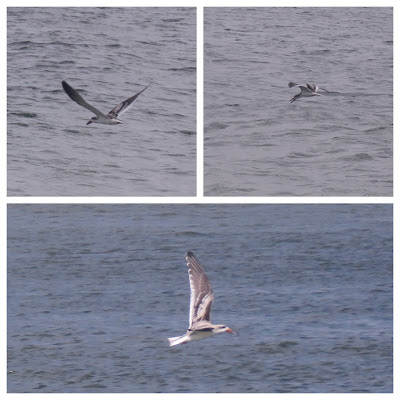 |
| Least Tern with an Atlantic Silverside photo by Patrick Carroll |
Chicks are coming out of the posting to get to the water or be the first to greet its parent bird coming in with a fish.
 |
| Black Skimmers with Atlantic Needlefish Photos by Patrick Carroll |
 |
| Black Skimmers with Striped Mullet Photos by Patrick Carroll |
LEAST TERNS (LETE) – Least Terns are spending the day feeding and protecting their MANY chicks from the heat and potential predators.
 |
| Least Tern chicks |
 |
| Five Least Tern chicks of varying sizes compete for lunch. |
 |
| A Least Tern fledgling comforts a new chick. |
After the initial flight lessons, we will begin seeing the chicks learn to hover over the water (to watch fish and judge how fast the fish are moving) and begin fishing very soon. Parent birds will continue to feed these fledglings as they improve on their new skills and through the migration.
COMMON TERNS (COTE) – Common Tern chicks and fledglings can be seen throughout the posting and on the beach and the COTE parents have been keeping beachgoers a safe distance away. The parent birds are encouraging the COTE fledglings to fly and are trying to motivate them to fly over the inlet. Fishing lessons should begin soon!
We also discovered two new Common Tern nests so little chicks are visible from the Masonboro Inlet side of the posting.
BLACK SKIMMERS (BLSK) – At sunrise on Thursday, July 1, a group of biologists met at the colony with Lindsay to band Black Skimmer chicks. We were able to band 27 BLSK chicks.
We also learned this week that we now have approximately 30 new Black Skimmer nests towards the front of the posting on the inlet side. Incubation continues!
Black Skimmer Chicks can be seen throughout the posting and are getting good size. We are seeing juvenile BLSK flying over the inlet and practicing skimming skills this week.
AMERICAN OYSTERCATCHERS (AMOY) – Two Oystercatcher chicks may be seen inlet side with the single parent bird EMY…and the un-banded helper bird. We were able to band the largest chick …ETX (who we call “Tex”) but the smallest chick was too little to band at that time.
 |
| Parent with both chicks. |
We are saddened to report that the smallest un-banded chick has sustained an injured wing this week and you will see the wing drooping. Our National Audubon biologist Lindsay Addison observed the chick on Sunday evening and unfortunately there is nothing we can do to help this bird. We talked at length about possible strategies, but prior attempts to rehab have consistently been unsuccessful. Chicks need to be able to fly to the oyster beds to learn firsthand from a parent bird how to feed themselves.
You will see the Oystercatcher chicks unsupervised on the beach during feeding and they are becoming rather “street/beach smart”. The chicks are very aware of people and run into the posting as vehicles or people approach.
Feeding of the AMOY chicks generally lasts 2 hours before and after low tide. It is especially important that you encourage beachgoers to stop and enjoy this unique opportunity to see Oystercatcher chicks feed from a safe distance.
IMPORTANT …LOOK FOR FISHING LINE!
Fishing line could potentially entangle the parent birds and/or chicks...just like the parent Oystercatcher who was injured. We have consistently found fishing line on the beach this week.





No comments:
Post a Comment